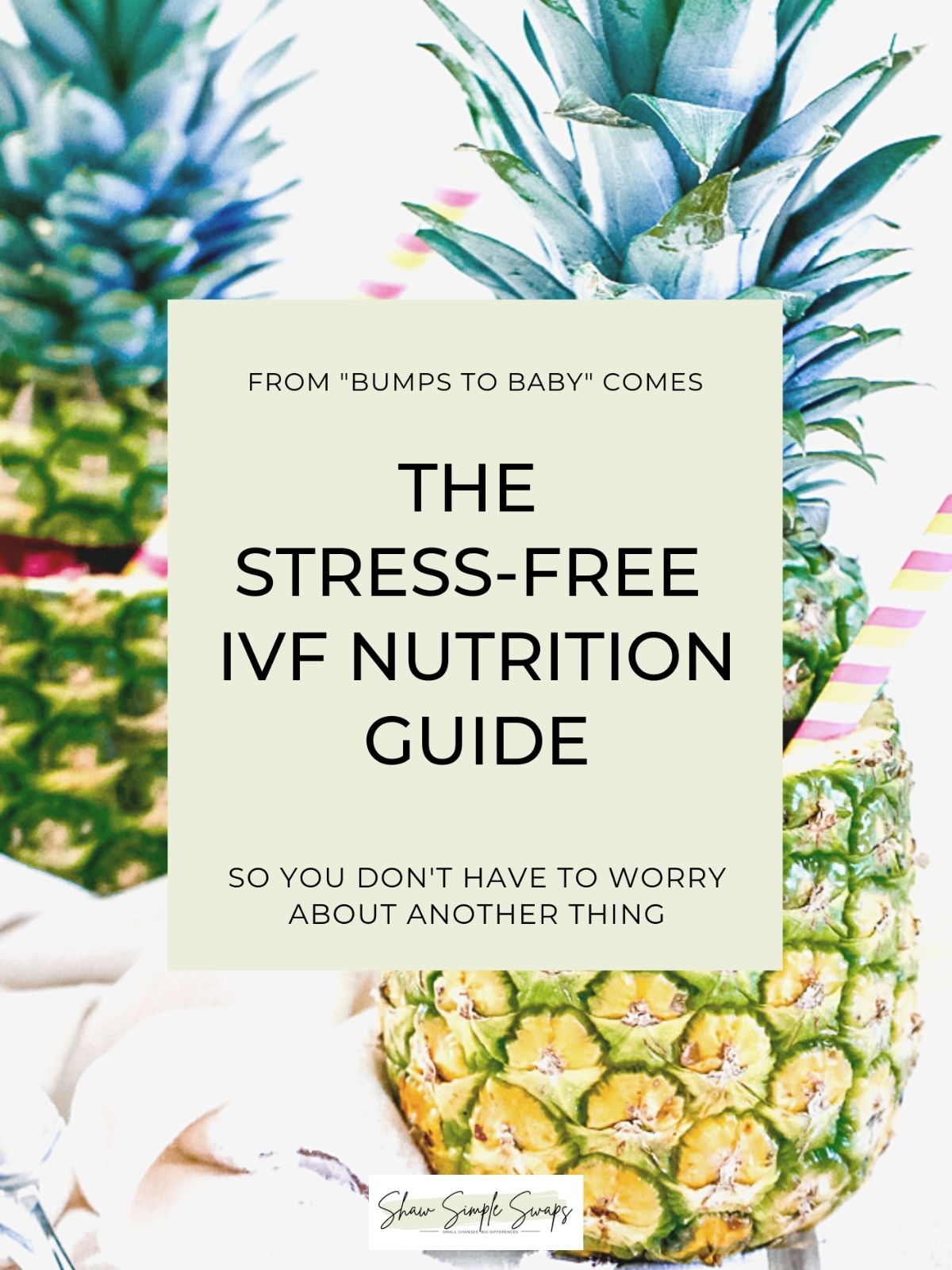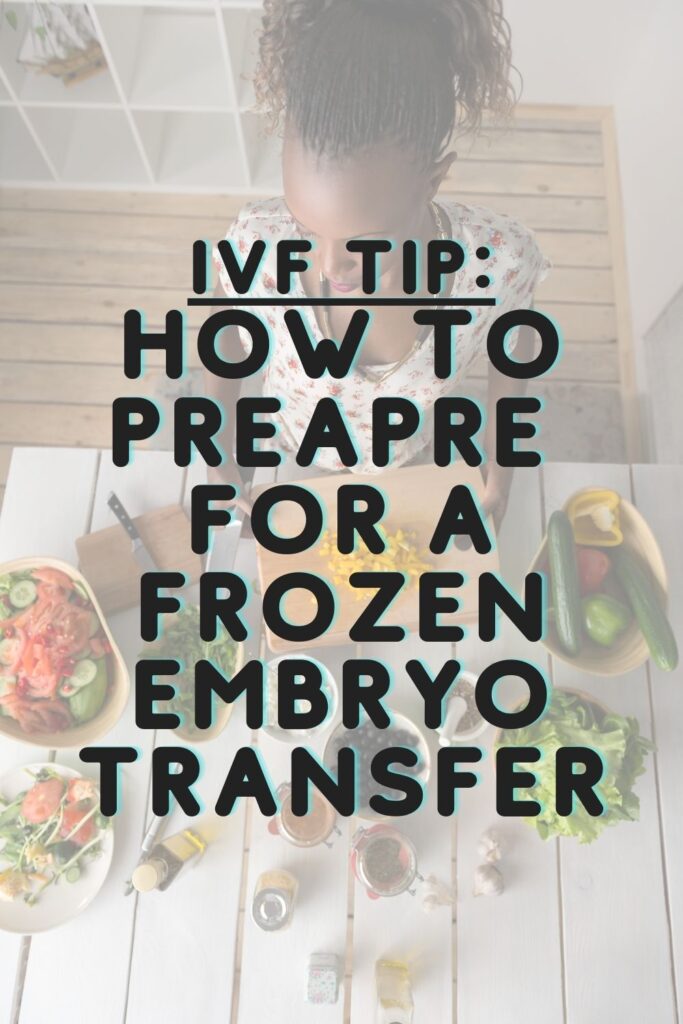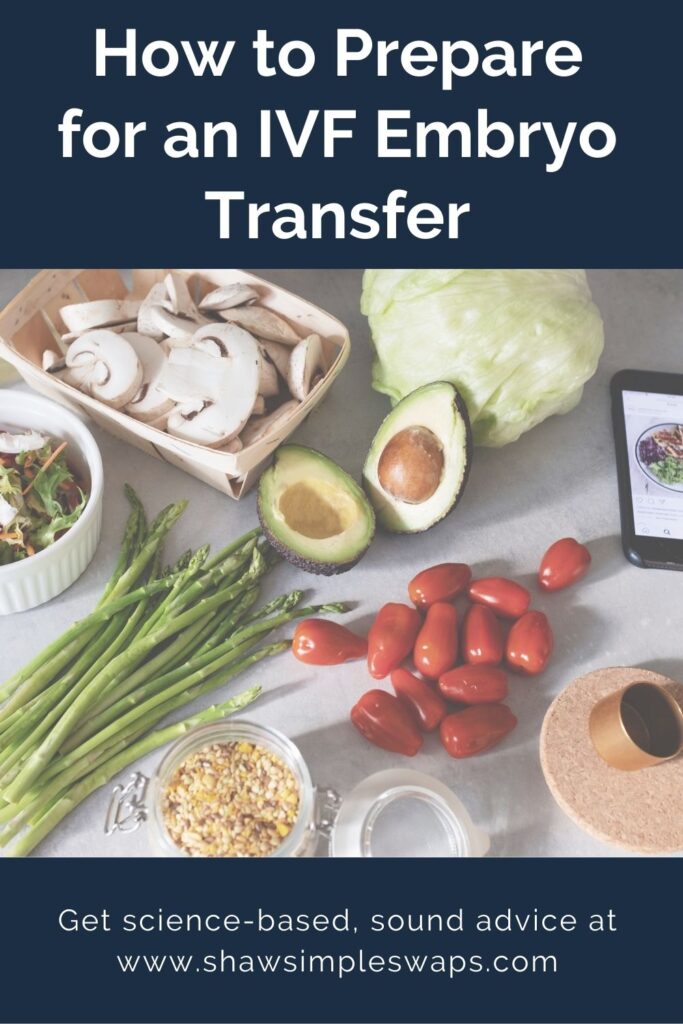Preparing for a fresh or frozen IVF Embryo Transfer? Then this post is for you. We’ll cover what you need to know about nutrition and preparing your body for the greatest chances of success. If you are awaiting your egg retrieval, then head to checkout this post here.

Jump to:
What You Need to Know About an IVF Transfer
If you’ve made it to the transfer stage on your IVF journey, congratulations! This is a true feat in and of itself!
As you prepare for this momentous occasion, there are a few things I want you to keep in mind.
- This is the easy part! No really. You’ve already been through the egg retrieval that is the most invasive. This is a piece of cake compared to that. In most cases, you’ll be in and out of your doctors office in less than an hour (paperwork included!)
- You don’t have to become house bound (unless you want to) post transfer. Keeping busy (in moderation of course) will help the waiting period go by quicker.
- You may have increased anxiety during the two week wait. This is completely normal. Talk to your doctor and if you can, I highly recommend seeking guidance from a therapist who specializes in reproductive care to offer support during this time.
- Most clinics will test your HCG levels (aka the pregnancy hormone) via a blood test 10 days post transfer. Every clinic is different, however if you can, do your best not to test at home.
- As much as you can, try to relax, destress, and focus on your most important job of the moment: creating a safe, nurturing place for that embryo baby!
The Difference Between a Fresh Embryo Transfer and Frozen Embryo Transfer
A fresh embryo transfer is when the embryo is transferred within a week after your retrieval (usually around day 5 post retrieval.)
A frozen embryo transfer occurs when your viable embryos are stored in cryopreservation after your retrieval until a future cycle when your medical team deems your body ready to accept a transfer. This seems to be the most common method I’m hearing from clients as it allows your body to recover from the stress of your retrieval before implanting the embryo.
However, please note there is no one-size fits all approach to this. The research is inconclusive and experts disagree as to whether a frozen or fresh embryo transfer has a higher success rate in regards to a positive pregnancy outcome.
Regardless if you are having a fresh or frozen embryo transfer, the same basic dietary and lifestyle management recommendations apply.
The only slight difference may be in regards to your sodium intakes with a fresh transfer if you are still recovering from mild fluid retention from the retrieval. However, please note if this is the case (re: fluid retention related to mild OHSS) your medical team will most likely recommend to wait a cycle or two before transferring. If you have any questions, please speak directly to your medical team.
What You Should Eat Before an Embryo Transfer
Here’s the deal: if you’ve already been following the Mediterranean style of eating (aka a fertility-friendly diet), you don’t need to modify much here.
What’s important is to remember that your soon to be embryo baby will be nestled (hopefully) into your uterus, meaning what you eat, they will be receiving too! It’s kind of cool to think that you are actually forming the taste preferences for your little one beginning in utero.
The most important thing you can do leading up to your transfer when it comes to nutrition is to ensure you have your body in optimal shape to “implant” that embryo. To do so, consider the following diet additions alongside your supplement regimen!

Foods to Incorporate Prior to an Embryo Transfer
Fruits and Vegetables
Think of “eating the rainbow” again when it comes to supplying your body with the powerful nutrients that can lower inflammation and kick the “bad guys” out of your body.
Foods like strawberries, wild blueberries, pistachios, pomegranates, cranberries, and many more are excellent additions to your diet.
Protein: Meats, Legumes, Pulses, Soy
Researchers have found that eating less animal protein and more vegetable proteins can help boost your fertility (Collins, 2015).
I’m not saying no meats are allowed, but rather the fertility nutrients often sought in animal proteins (read: iron and zinc) can also be found in plant sources. Aim for balance and find a flow that works for you.
For instance, if the thought of Meatless Monday 24/7 makes you cringe, don’t worry. You can use a vegetarian protein like eggs (hello, you’re also sneaking in the important nutrient choline there, too, which we’ll get to below) and top just about anything with it!
But, if you do crave meat, allow yourself to enjoy poultry weekly and aim to use it more sparingly. For instance, if you enjoy lean turkey, try to use it blended with mushrooms to enhance flavor (hello, umami!) and boost the nutrient density of that meal.
Fish and Seafood
While fish and other seafood choices are certainly sources of protein, I’ve moved them into their own section because they show so much promise specifically with not only your lifelong health, but also maternal health at large.
Studies have shown that the long-chain polyunsaturated healthy fats (known as omega-3s) found in fish and seafood have a direct effect on estrogen levels, the number of follicles and embryo morphology after ovarian stimulation (Hammiche, 2011).
Due to concerns over individuals meeting their intakes, recommendations are that you should aim to eat at least two servings of fish/seafood a week. There is still some concern over the mercury content of fish, thus the best recommendations are to eat fish and seafood that are lower in mercury.
Dairy Foods: Milk, Yogurt, Kefir, Cheese
The dairy case is still a controversial topic. However, a review published in 2017 found dairy is less likely to have an important role in your fertility (Gaskins, 2017).
Now, this is contradictory to what was found in the data from the Nurses Health Study II that demonstrated whole milk dairy had a positive effect on those with ovulatory dysfunction.
Here’s my recommendation: If you like milk, yogurt and cheese, feel free to enjoy it in moderation. Aim for whole milk varieties that will provide more satiety as well as potentially assisting with regulating your hormones.
Hearty Healthy Fats: Nuts, Seeds, Oils
For your IVF cycle, it’s important to eat nutrient-dense sources of fat like avocados, chia seeds, flaxseeds, olive oil, and nuts, to help increase your intake of those unsaturated fatty acids that dominate the Mediterranean style of eating.
The key to this nutrient group comes down to portion control. As hard as it may be, it’s important you’re using the right serving sizes when it comes to pouring olive oil on your salad or grabbing a handful of nuts as you run between appointments.
To keep things easier on you, I’d recommend putting a teaspoon out near your olive oil bottle and measuring out 2-3 teaspoons when you’re using it to toss a serving of vegetables, and stick a tablespoon into your jar of nuts! This will allow you to be more mindful of your portions and help you get the good for you fats in your diet!
Whole Grains / Complex Carbohydrates
If you’ve heard someone scream, “GLUTEN IS THE DEVIL”, I’m here to tell you that’s far from the truth. Gluten is a protein found in wheat that CAN have an inflammatory effect on individuals who are diagnosed with Celiac disease or have a diagnosed gluten sensitivity. If you are one of these people, then you need to eliminate gluten from your diet in order to have the highest success of minimizing inflammation in your body and increasing your fertility.
But, if you are NOT gluten sensitive, then the evidence actually points in the opposite direction when it comes to whole grains. Women who consumed approximately 1.2 servings had a higher probability of successful implantation and live birth (Gaskins, 2016).
Not all grains are created equal, so regardless if you are diagnosed with polycystic ovary syndrome (PCOS), endometriosis or another hormonal condition, aiming to include more low-glycemic grains (read: those grains that won’t spike your blood sugars as much as their counterparts) is the best thing you can do.
Consider adding quinoa, amaranth, brown rice, etc. to your meal plan.
Other Factors to Keep in Mind While Preparing
Your emotional health is just as important as your physical health on this journey. Consider the following therapeutic options to help manage your stress and anxiety during this time as well:
- Yoga
- Journaling
- Therapy
- Support groups
- Acupuncture
- Massages
- Prayer
What I Want You to Know
There is no “one size fits all approach” to IVF nutrition. Individual counseling with a registered dietitian to help personalize your nutrition plan is ideal, however I know not everyone can budget that on top of IVF expenses.
To help make the science more accessible, I put together The Stress-Free IVF Nutrition Guide. It’s a one-stop to providing you sound information alongside delicious and nutritious recipes at your fingertips.

FAQs
This is HIGHLY individualized. While I go over the specific supplements for IVF in The Stress-Free IVF Nutrition Guide, the one supplement across the board I recommend for all clients is a quality prenatal vitamin. You should start to take this at least three months before your IVF retrieval and continue through postpartum.
This depends on your current workout schedule and style. I recommend speaking to your medical team about this. If working out is a form of therapy and you do not have another condition (i.e. hypothalamic amenorrhea, female athlete triad, disordered eating, etc.), I do encourage my clients to continue their workouts yet modified. If you are a runner, consider jogging a shorter distance. For weight lifting, modify weights and number of sets. I typically also have clients refrain from abdominal workouts during the two week wait after transfer as well.
Usually by 10 days post transfer the pregnancy hormone, HCG, will begin to rise in your blood. I do not recommend taking at home pregnancy tests (they are not always reliable.) Wait until your doctors blood draw to confirm. You can do it, I promise!
If you need to have your “coffee fix”, then in moderation (i.e. no more than 8 ounces per day) it’s ok. While the research remains mixed, it’s best to monitor your caffeine and stick to no more than 8 ounces of coffee per day (if necessary). The best rule of thumb is to drink caffeine-free tea or a decaf cup of coffee. Sorry Starbucks, but use that extra money to fund your self-care!
There’s no literature that has really measured this, however the best rule of thumb is to minimize your intake if regular drinking is a part of your lifestyle. After all you are preparing your body to nourish another life for nine months, and during that time, it’s recommended to not drink for the growth and development of your baby. If you do feel like a glass of wine or beer, stick to no more than 5 ounces of wine or a 12 ounce beer.
References
Collins, G., & Rossi, B. (2015). The impact of lifestyle modifications, diet, and vitamin supplementation on natural fertility. Fertility Research And Practice, 1(1). doi: 10.1186/s40738-015-0003-4
Gaskins, A., & Chavarro, J. (2017). Diet and fertility: a review.
Gaskins, A., Chiu, Y., Williams, P., Keller, M., Toth, T., Hauser, R., & Chavarro, J. (2016). Maternal whole grain intake and outcomes of in vitro fertilization. Fertility And Sterility, 105(6), 1503-1510.e4. doi: 10.1016/j.fertnstert.2016.02.015
Hammiche, F., Vujkovic, M., Wijburg, W., de Vries, J., Macklon, N., Laven, J., & Steegers- Theunissen, R. (2011). Increased preconception omega-3 polyunsaturated fatty acid intake improves embryo morphology. Fertility And Sterility, 95(5), 1820-1823. doi: 10.1016/j.fertnstert.2010.11.021




